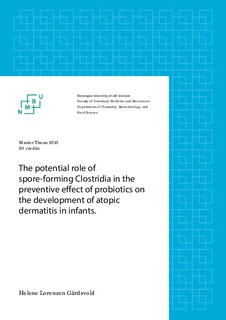| dc.description.abstract | As the prevalence of infectious disease has decreased, the prevalence of allergic diseases has increased. The hygiene hypothesis points to a possible correlation between increased prevalence of allergic diseases, and modernization of homes, better hygiene, and smaller families. With the discovery of health benefits reaped from probiotic bacteria, several studies have been conducted to see if the intake of probiotica can have a preventive effect on the development of allergic diseases, and most of these studies have concluded that probiotica have a preventive effect on the development of allergic diseases. What is not known, however, is the mechanisms behind the preventive effect probiotica has on development of allergic diseases. One possible mechanism is thought to be that the intake of probiotica will cause alterations of the timeframe of when members of Clostridium clusters IV and XIVa colonize the infant gut, and start their production of the short chain fatty acid butyrate. As both the bacteria and the produced butyrate is known to have an effect on the immune system, the hypothesis is that a change in the normal colonization pattern can lead to the development of allergic diseases.
To test this hypothesis, fecal samples from the Pro-PACT study were treated with chloroform and heat to isolate, and then cultivate, endospores formed by members of Clostridium clusters IV and XIVa. Gas-liquid chromatography was used to detect the presence of butyrate in the cultivated samples. qPCRs specific for members of Clostridium clusters IV and XIVa, as well as Illumina sequencing were used to identify the bacteria present in the cultivated samples.
The results show that the main difference between the Biola and placebo groups is that there is a higher prevalence of members of Clostridium clusters IV and XIVa in the samples collected from the placebo group. The concentration of butyrate found in the samples are highly correlated with the amount of Clostridia in the samples. It was also discovered that the prevalence of Clostridia species is lower amongst children who have developed an allergic disease. However, this is true for both Biola and placebo groups, suggesting that the colonization of Clostridia is not a direct cause of development of allergic diseases, but rather that the differences between the bacterial composition in the Biola and placebo groups is a result of other bacteria who have colonized the infant gut instead of Clostridia, and thus is a more probable cause for the development of allergic diseases in children. | nb_NO |

